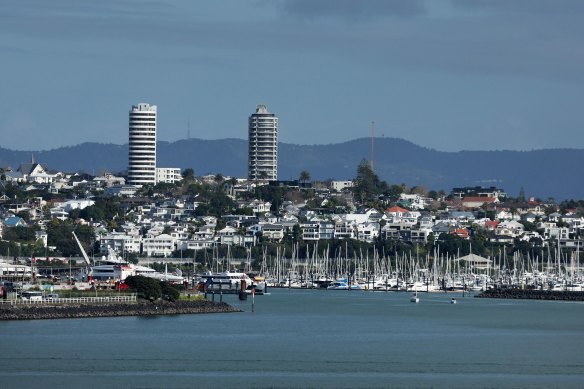Australia’s peak business lobby has urged policymakers to follow the lead of Auckland in New Zealand by radically rezoning large swaths of the country’s cities for higher-density housing.
Citing research that said rents in Auckland were up to 33 per cent lower than they would have been without the mass rezoning, the Business Council of Australia challenged state governments to go much further to loosen planning restrictions that limit housing supply.

A paper by two New Zealand academics found Auckland planning reforms lifted supply and reduced rents by as much as a third.Credit: Bloomberg
The Auckland reforms were notable for applying to about 75 per cent of the city’s residential land, dramatically increasing housing capacity – especially medium-density – in what Auckland Council described as a world-first rezoning of such scale.
In NSW, the BCA is urging Labor to turbocharge its signature transport-oriented development program by lifting building heights near train stations to 15 or 20 storeys from the current seven, applying the policy to more stations, light rail stops and ferry wharves, and increasing the radius from the transport node from 400 metres to 800.
“At the end of the day, 800 metres is not that far to walk,” said BCA chief executive Bran Black, a chief-of-staff to former premier Dominic Perrottet.
The business lobby’s latest recommendation is part of a campaign to increase housing supply and overhaul planning laws that began on Monday with a call to strip local councils of their power to approve or reject developments if they drag the chain.
It seizes on a piece of academic research – also cited by the NSW Productivity Commission – that found Auckland’s 2016 rezoning generated planning permits for 22,000 new homes, or about 4 per cent of the city’s total housing stock, and put significant downward pressure on rents.
The study by Ryan Greenaway-McGrevy and Peter Phillips, published in the Journal of Urban Economics, said that six years after the changes were implemented, rents for three-bedroom dwellings in Auckland were 26 to 33 per cent less than they would have been without the policy, and rents for two-bedroom dwellings were 21 to 24 per cent cheaper.
However, the research has been challenged by Australian academic Cameron Murray and NZ-based economist Tim Helm, who said home-building in Auckland was already increasing and rents would have fallen anyway without the zoning changes.
Zoning policy controls what type of development can be built on a given lot, as well as the height and floor space ratio. Generally, this is set under councils’ local environmental plans, informed by long-term land use planning strategies.
On top of mass rezoning, the BCA wants states such as NSW to enforce consistent definitions for what each zone means, based on the South Australian model. “In NSW, as far as we can see, there are about 530 different planning instruments that can apply in this regard,” Black said.
NSW Premier Chris Minns has trumpeted his government’s planning reforms as the largest rezoning in NSW history. Black credited Labor with taking “positive steps forward”, but said there was clearly more to do.
“We’re coming off a reasonably low base. In order for us to deliver on our national targets … that translates to nine homes per 1000 people delivered each and every year. In NSW at the moment, we’re sitting at five, and the national average is six.”
Black conceded the expense of construction materials, and labour shortages, meant it would be difficult to build that many homes, even if more land was rezoned, but all steps had to be taken.
Planning Minister Paul Scully was contacted for comment on the BCA proposals. At an event last week, Scully said it was the government’s job to balance the demands of communities, developers and councils, which it was doing with its rezoning of eight “accelerated precincts” near train and metro stations, which would be finalised soon.
“Everyone needs to understand that they need to give a little to gain a lot,” Scully said.
Rick Graf, development director at apartment builder Billbergia, said, given the state’s housing targets required NSW to build twice as many homes as it does, “we ought to be doing housing everywhere we can, to the maximum extent that we can, for as long as we can”. He said every transport-oriented development suburb should be closer to 30 storeys, not six.
“It should be as much as the infrastructure around it will permit. But in most cases, if that’s not there, enabling a TOD of that density will produce the funding necessary to deliver it,” Graf said.
“So it’s a virtuous circle. You get more people, you get more contributions, you’re able to provide more infrastructure.”
Start the day with a summary of the day’s most important and interesting stories, analysis and insights. Sign up for our Morning Edition newsletter.